There’s No Place Like Ohm: CES 2020
The Writers Workbench makes its annual trek to “Disneyland for Adults” to seek out the winners of its “Cool Thing Awards.”
January 18, 2020Robert J. Elisberg
Yes, it’s here at last. The Most Wonderful Time of the Year—the 2020 Consumer Electronics Show, held each year in Las Vegas. What I refer to as Disneyland for Adults. Yes, yes, the event is too huge, too crowded and too noisy, but the adventurous backpacking through Tech Land is a joy for seeing what’s coming in the world of technology.
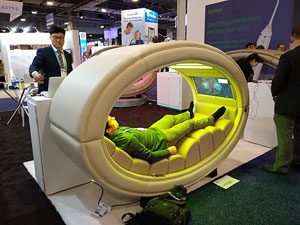 Before heading to the show, my Inbox before every CES always gets inundated with companies trying to interest you in their greatest, first-of-a-kind, best product ever. And culling through them, I generally get a sense of what Big Themes will permeate the even—the types of breakthrough technologies that push the market ahead. And this year, my observation is that the answer is—none. Mostly, it was a lot of “stuff.” (Which is the technical term…) To be clear, it’s all impressively advanced “stuff,” but it’s still “stuff.”
Before heading to the show, my Inbox before every CES always gets inundated with companies trying to interest you in their greatest, first-of-a-kind, best product ever. And culling through them, I generally get a sense of what Big Themes will permeate the even—the types of breakthrough technologies that push the market ahead. And this year, my observation is that the answer is—none. Mostly, it was a lot of “stuff.” (Which is the technical term…) To be clear, it’s all impressively advanced “stuff,” but it’s still “stuff.”
Several fields did stand out at the show, such as health and wellness, Smart homes, wearables, and 5G (though not quite mainstream yet), along with oceans of drones and gaming. There also seemed to be a greater application of AI (artificial intelligence) into products. All these are large consumer fields, but what was there seemed mainly an extension of last year, not advances.
To be clear, this is nothing new. I’ve long had a tech theory about Big Themes. I’ve found that they usually run for 3-4 years, and then technology gets so mature that innovation has to take a year off to breathe, so it can catch up. I think we’re just in one of those years.
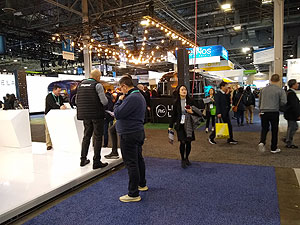 Importantly though, trekking through the CES jungle always finds a range of fascinating devices, technologies and changes that catch your eye. Moreover, one of the major points of CES is find what companies are developing, to see the direction it’s all headed. (Indeed, that’s why I visit Eureka Park, a huge area at the Sands Expo, separate from the main center of CES. It’s where start-ups, entrepreneurs, and lesser-known international companies trying to break into the U.S. market set up shop.) And not only did many products leap out at the show, but three of them were seriously impressive. One was absolutely fascinating for what it promises to travelers, and its use in future applications. Another, in the medical field, may be one of the best products I’ve seen in all my years covering CES. More on them in detail later.
Importantly though, trekking through the CES jungle always finds a range of fascinating devices, technologies and changes that catch your eye. Moreover, one of the major points of CES is find what companies are developing, to see the direction it’s all headed. (Indeed, that’s why I visit Eureka Park, a huge area at the Sands Expo, separate from the main center of CES. It’s where start-ups, entrepreneurs, and lesser-known international companies trying to break into the U.S. market set up shop.) And not only did many products leap out at the show, but three of them were seriously impressive. One was absolutely fascinating for what it promises to travelers, and its use in future applications. Another, in the medical field, may be one of the best products I’ve seen in all my years covering CES. More on them in detail later.
And that leads us to one last word, a tradition of this annual column. It’s our official warning: this will be long. Not in a cutesy way, but in a 7-volume Remembrances of Things Past Marcel Proust kind of way. The point is to give readers a sense of what went on at CES and what kind of direction the tech world is offering for the coming year. If that’s the sort of thing that interests you, dive in! If it isn’t, fair enough and very understandable—just no complaining. You’ve been warned.
And so, putting on my pith helmet, let’s head in.
One of the fields that I’ve generally avoided over the years has been health and wellness. Not because it’s been uninteresting—in fact, many of the items have been great—but the best have usually been for specific medical purposes and less as general consumer products. This year, I was impressed by how many bridged the gap, the following of which all received CES Innovation Awards—
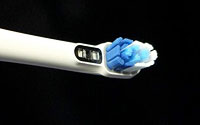 Some of these Innovation winners were admittedly on a low-key level, like the Colgate Plaqless Pro. I’ve come across Smart toothbrushes at tech shows for several years, but this is the first I’ve seen that wasn’t, well…sort of stupid. Others have been gimmicky, using apps to show you how to brush your teeth properly. Most people have figured that out by their teen years, and one reminder should do the trick, not a daily eToothbrush lesson. (That said, I do think app “games” meant to inspire kids to brush better are a fine use.) But the Plaqless Pro is actually valuable. It has a sensor which can recognize the fluorescents in plaque, and when you’ve finally brushed it off completely, the blue light on the toothbrush will turn white. There are other features with the app, but the sensor is the one that actually matters.
Some of these Innovation winners were admittedly on a low-key level, like the Colgate Plaqless Pro. I’ve come across Smart toothbrushes at tech shows for several years, but this is the first I’ve seen that wasn’t, well…sort of stupid. Others have been gimmicky, using apps to show you how to brush your teeth properly. Most people have figured that out by their teen years, and one reminder should do the trick, not a daily eToothbrush lesson. (That said, I do think app “games” meant to inspire kids to brush better are a fine use.) But the Plaqless Pro is actually valuable. It has a sensor which can recognize the fluorescents in plaque, and when you’ve finally brushed it off completely, the blue light on the toothbrush will turn white. There are other features with the app, but the sensor is the one that actually matters.
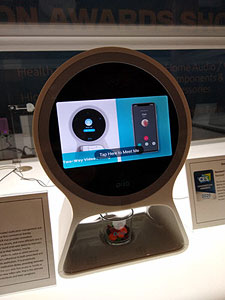 I’m always asked after CES what “cool things” I saw, and what people generally mean is something whiz-bang and flashy. But for me, a cool thing is something that helps people do something much easier and better that they do every day. And it can be the most simple-seeming item in the world—which is precisely what we have here, our first Cool Thing Award. And from Black & Decker, of all companies, which is far more known for its power drills than medical devices. However, that’s what its Pria is, an automated medication manager and home health care assistant. The Pria is intended for elderly people who take a menagerie of pills each day and might have a difficult time remembering the full regimen. Basically, you put all your medication in the device in separate compartments and then program it so that it will dispense the proper dosages each day. And better still, there's also a built-in camera and monitor so that you can have 2-way video communication with a family member or your doctor.
I’m always asked after CES what “cool things” I saw, and what people generally mean is something whiz-bang and flashy. But for me, a cool thing is something that helps people do something much easier and better that they do every day. And it can be the most simple-seeming item in the world—which is precisely what we have here, our first Cool Thing Award. And from Black & Decker, of all companies, which is far more known for its power drills than medical devices. However, that’s what its Pria is, an automated medication manager and home health care assistant. The Pria is intended for elderly people who take a menagerie of pills each day and might have a difficult time remembering the full regimen. Basically, you put all your medication in the device in separate compartments and then program it so that it will dispense the proper dosages each day. And better still, there's also a built-in camera and monitor so that you can have 2-way video communication with a family member or your doctor.
The AerBetic deals with an invasive issue that diabetics have when constantly monitoring their condition, usually with finger pricks. This instead is a wearable device whose sensor detects the gases emitted in a diabetic’s breath or by their skin, much in the same way that service dogs have sniffed out for years.
The FootWARE is a health-tracking Smart shoe. But more than arch support, it can measure one’s heart rate, respiratory rate, and blood pressure, as well as (apparently) a person’s stress level and movement patterns, including if one has an abnormal gait.
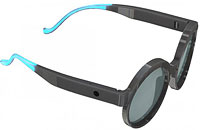 That brings us to my second Cool Thing Award, which is for the LexiLens. But that doesn’t quite go far enough, because the LexiLens is one of those remarkable products I mentioned above. It not only is one of the two best things I saw at this year’s show, it’s one of the best things I’ve seen at all the CES shows I’ve attended over the past 15-20 years. It’s a pair of eyeglasses for those with dyslexia that allows them to read words clearly. The short version I got when speaking to Michael Kodochian, CEO and founder of the French company Abeye, is that people with dyslexia see mirror images of letters, and these glasses are able to identify the mirrored letters and filter them out. There are many different kinds of dyslexia but all have a certain foundation, and the most common kind affects 80% of those with the condition, so this would work for them. Kodachian says the company is continuing to work on the other 20%, but even those people should see at least some benefit from the current model. Honestly, I have no idea if it works, though they showed me a product reel with testimonials from users, and also a video Kodachian made on his phone that very morning from someone with dyslexia who saw their booth and stopped by. (The expression on the visitor’s face said almost more than his words.) The technology is based on the findings of a 2017 French study on dyslexia, and the company is working with an organization, the Atol les Opticiens group. In addition, they did their own research study of 200 people.
That brings us to my second Cool Thing Award, which is for the LexiLens. But that doesn’t quite go far enough, because the LexiLens is one of those remarkable products I mentioned above. It not only is one of the two best things I saw at this year’s show, it’s one of the best things I’ve seen at all the CES shows I’ve attended over the past 15-20 years. It’s a pair of eyeglasses for those with dyslexia that allows them to read words clearly. The short version I got when speaking to Michael Kodochian, CEO and founder of the French company Abeye, is that people with dyslexia see mirror images of letters, and these glasses are able to identify the mirrored letters and filter them out. There are many different kinds of dyslexia but all have a certain foundation, and the most common kind affects 80% of those with the condition, so this would work for them. Kodachian says the company is continuing to work on the other 20%, but even those people should see at least some benefit from the current model. Honestly, I have no idea if it works, though they showed me a product reel with testimonials from users, and also a video Kodachian made on his phone that very morning from someone with dyslexia who saw their booth and stopped by. (The expression on the visitor’s face said almost more than his words.) The technology is based on the findings of a 2017 French study on dyslexia, and the company is working with an organization, the Atol les Opticiens group. In addition, they did their own research study of 200 people.
On the far-other end of the health and wellness spectrum is the Mateo Smart bathmat, which is smart enough to do more than sop up water. It will monitor your body weight, body composition and posture evolution (whatever that exactly is), among other things, most of which were too meaningless to me to write down. It’s certainly a clever design, and I suppose ideal for those who like a stylish bathroom, uncluttered by bulky, mechanical devices, though personally I think smarter than a smart bathmat is a basic scale and mirror, but hey, that’s just me.
If you’re especially concerned with your body weight, then it’s a short step to move away from these Innovation Award winners to consider the matter of food. And that’s become a big area at CES. But no, there is alas not yet a Smart banana cream pie.
Smart thermometers have been around for a few years, but I particularly liked some of the features the Meater offered at the U.K. pavilion in Eureka Park. Being wireless, you can monitor over WiFi what you’re cooking, and set the temperature you want the food to reach—and then have the app buzz your mobile phone when it’s ready. The basic model will retail for $69 and have a range of 30 feet. The higher end model’s extended range is 165 feet.
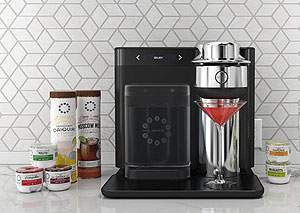 If you’re a fan of Keurig coffee, the company is coming out with Drinkworks, based on the same simplicity principle of single-serving pods but for making cocktails. Each pod contains everything you need, including the alcohol, and you only add water. They offer about two dozen types of mixed-drinks. And yes, it comes with a lock to keep kids out. The device will retail for $300, and each pod is $5 (or a tube of four for $17.)
If you’re a fan of Keurig coffee, the company is coming out with Drinkworks, based on the same simplicity principle of single-serving pods but for making cocktails. Each pod contains everything you need, including the alcohol, and you only add water. They offer about two dozen types of mixed-drinks. And yes, it comes with a lock to keep kids out. The device will retail for $300, and each pod is $5 (or a tube of four for $17.)
(I saw a similar product, the Bartesian, which is also a single-serve cocktail machine. The one difference is that the base alcohol is not included in a capsule, just the bitters, extracts and flavoring, which seems a big difference. However, this allows one to adjust the strength of the drink.)
Speaking of beverages, for those in a rush the Juno is able to chill a soft drink cab from temperature in just two minutes, and a bottle of wine in five minutes.
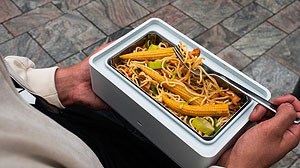 I was quite taken by the Heatbox, an upcoming product at the Holland pavilion in Eureka Park, which gets another of my Cool Thing Awards. This is a lunch box that will heat up the food inside and let you have a hot lunch. You add water in the bottom, which is heated and the resulting steam then warms the food. (Clearly it’s not intended good for is anything crispy, like bacon or toast.) The Heatbox is wireless and rechargeable, can be used three times on a single charge, and weighs two pounds. It will retail for around $170 and go into production in March.
I was quite taken by the Heatbox, an upcoming product at the Holland pavilion in Eureka Park, which gets another of my Cool Thing Awards. This is a lunch box that will heat up the food inside and let you have a hot lunch. You add water in the bottom, which is heated and the resulting steam then warms the food. (Clearly it’s not intended good for is anything crispy, like bacon or toast.) The Heatbox is wireless and rechargeable, can be used three times on a single charge, and weighs two pounds. It will retail for around $170 and go into production in March.
Also straddling the line between food and appliance categories, though more in the appliance end, are a couple of wonderful, portable items for apartment kitchens.
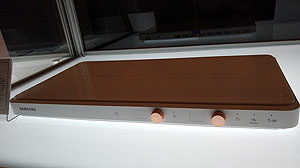 One of these is an offshoot of a product I've written about for a few years and like very much but isn't available in the U.S. readily, and that’s the induction stove top. (These are cool to the touch but heat up metal.) Induction stoves are growing in popularity in Europe, but in the U.S. they require a complete rewiring of kitchens and a standard that isn't totally compatible to what utilities provide. (At least that's somewhat how it’s been described to me.) But at CES, Samsung had an induction stovetop that is portable, intended for small apartments. So, I have to assume that, being portable, it might at least have a better chance of being usable in the U.S.
One of these is an offshoot of a product I've written about for a few years and like very much but isn't available in the U.S. readily, and that’s the induction stove top. (These are cool to the touch but heat up metal.) Induction stoves are growing in popularity in Europe, but in the U.S. they require a complete rewiring of kitchens and a standard that isn't totally compatible to what utilities provide. (At least that's somewhat how it’s been described to me.) But at CES, Samsung had an induction stovetop that is portable, intended for small apartments. So, I have to assume that, being portable, it might at least have a better chance of being usable in the U.S.
 Also for kitchens in small apartments is another Cool Thing Award-winner—though I would have written about it even if I wasn’t impressed, since the product’s name is “Bob.” This was at the always-large La French Tech contingent at Eureka Park. It's a portable dishwasher, about the size of a large microwave. It's for apartments that don’t have room for a full-sized dishwasher or perhaps an office with a small kitchen. Weighing 22 pounds, it holds two place-settings of dishes, and is very eco-efficient, using only half-a-gallon of water for its "fast cycle" of 20 minutes. (Slightly more for a longer, in-depth cleaning.) It can be hooked up to a water line, like a normal dishwasher, but you can also just add water manually, and then drain it in the sink. And for all that and its significant usefulness, it too gets a Cool Thing Award. Made by Daan Tech, it will be available in France this September, with U.S. pre-orders starting in May and availability here in late-2020 or the beginning of next year. The nicely-named Bob will sell for around $400.
Also for kitchens in small apartments is another Cool Thing Award-winner—though I would have written about it even if I wasn’t impressed, since the product’s name is “Bob.” This was at the always-large La French Tech contingent at Eureka Park. It's a portable dishwasher, about the size of a large microwave. It's for apartments that don’t have room for a full-sized dishwasher or perhaps an office with a small kitchen. Weighing 22 pounds, it holds two place-settings of dishes, and is very eco-efficient, using only half-a-gallon of water for its "fast cycle" of 20 minutes. (Slightly more for a longer, in-depth cleaning.) It can be hooked up to a water line, like a normal dishwasher, but you can also just add water manually, and then drain it in the sink. And for all that and its significant usefulness, it too gets a Cool Thing Award. Made by Daan Tech, it will be available in France this September, with U.S. pre-orders starting in May and availability here in late-2020 or the beginning of next year. The nicely-named Bob will sell for around $400.
I guess if we’re going to start with food, and then go to stovetops and dishwashers, it only follows to end up with trash. So, that’s where we come to the Townew intelligent trashcan, for those with garbage, but who don’t want to touch it. This self-seals the trashbag and replaces it with the next liner. Alas, you have to throw it out yourself. Or give it to your butler.
Of course, the most popular appliance in any home is probably the television. This is another of those fields I tend to avoid at CES since the differences between one set and another at similar levels tend to be meaningless and just subjective taste. But this year I came across some tweaks for the venerable box worth noting.
On the purely geek level, know that as most of the world is getting settled on sets with 4K resolution there was a greater push for 8K. While the image is spectacular, know that not only is the cost, as well, but also there’s no native 8K content to take advantage of the technology. It’s like hoping to play the latest BluRay DVD on a phonograph.
The challenge today for TV makers, in general, is to add new features to a product that is impressively mature and largely does what consumers already want.
 One such feature that I saw on a few sets is to turn them into art frames. This has been around for a few years, but Samsung had one of the better I’ve seen. It’s a high-quality QLED monitor that displays artwork on your wall when the wall-TV is off. What’s notable is that they have an art store with 1,200 pieces of high end art which you can subscribe to for $5 a month, and keep changing the picture, or pay for individual works that run no more than $20 each.
One such feature that I saw on a few sets is to turn them into art frames. This has been around for a few years, but Samsung had one of the better I’ve seen. It’s a high-quality QLED monitor that displays artwork on your wall when the wall-TV is off. What’s notable is that they have an art store with 1,200 pieces of high end art which you can subscribe to for $5 a month, and keep changing the picture, or pay for individual works that run no more than $20 each.
TCL had its own twist on the art frame that was unique though gimmicky—you can upload any of your own photos, and use the built-in “AI Photo Animator,” using artificial intelligence to manipulate the photos with different filters.
AI was a feature that seemed to be integrated into more TVs than in the past. Konka Interactive TV, for instance, offered a virtual gym, and an artificial intelligence filter camera that can alter images much like the aforementioned TCL. The virtual gym was more interesting and valuable.
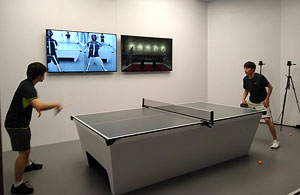 And Sony had a TV “enhanced by AI” that was gimmicky, as well, but still fascinating and might be fun in some applications. It added a graphic overlay that not only turned normal video images into cartoons, but could also be watched from different angles, like movie cuts. They had a live demonstration of two people playing ping pong, and when you watched it on the Sony TV, it looked like Renaissance warriors battling out the match. (This photo doesn’t do it justice, but you can get an idea of the image in the upper right.)
And Sony had a TV “enhanced by AI” that was gimmicky, as well, but still fascinating and might be fun in some applications. It added a graphic overlay that not only turned normal video images into cartoons, but could also be watched from different angles, like movie cuts. They had a live demonstration of two people playing ping pong, and when you watched it on the Sony TV, it looked like Renaissance warriors battling out the match. (This photo doesn’t do it justice, but you can get an idea of the image in the upper right.)
The “IMAX Enhanced” system had a major presentation called The Most Immersive At-Home Theater Experience. (“Immersive” was a big word at CES.) It was flashy, but I found it a yawn. Not for what it did—it was extremely good—but it didn’t seem significantly better from any high-end, large screen TV and good surround audio system. Theirs did digitally remaster certain material from content providers who have signed up with IMAX (like Sony Pictures, Paramount and Fandango Now) that made for clearer images and scaled resolution in a way that apparently lets you see more picture. But if it was noticeably better, they did a poor job of demonstrating it.
On the technobabble level, the TV industry is now making a very big push for a new standard called ATSC 3.0. Mind you, this will be meaningless to most people in the U.S., but the short version is that it allows for high definition and Internet capabilities in over-the-air broadcasting, meaning those without cable, and could have major impact in other parts of the world.
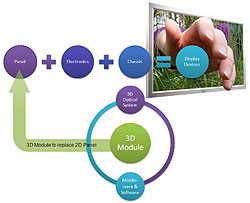 I mention this, too, because at a panel discussion on ATSC 3.0, a network executive said he felt the time was right for there to finally be glassless 3D TV. And so that brings us to my annual update on my favorite new TV technology I’ve been writing about for seven years that will be a game-changer if and when it gets past the “Coming Soon” stage. That’s the folks at Stream TV Networks who have developed their Ultra-D technology for 3D TV that can be watched without special glasses. Further, unlike with the failed 3D TV with glasses there is no issue with content being available because it not only can convert 2D material to 3D but do so in realtime, like for live sports events (or any old movie—their booth was running It’s a Wonderful Life in glassless 3D). Also, you can adjust any of this to whatever level of 3D that you want—from viewing with high “pop” 3D to having less of a 3D image but sharper resolution. Or you can turn the 3D off entirely for shows where it’s not needed. Plus, the 4K panel is configured to what they call “8K Lite”—almost 8K quality but significantly less expensive.
I mention this, too, because at a panel discussion on ATSC 3.0, a network executive said he felt the time was right for there to finally be glassless 3D TV. And so that brings us to my annual update on my favorite new TV technology I’ve been writing about for seven years that will be a game-changer if and when it gets past the “Coming Soon” stage. That’s the folks at Stream TV Networks who have developed their Ultra-D technology for 3D TV that can be watched without special glasses. Further, unlike with the failed 3D TV with glasses there is no issue with content being available because it not only can convert 2D material to 3D but do so in realtime, like for live sports events (or any old movie—their booth was running It’s a Wonderful Life in glassless 3D). Also, you can adjust any of this to whatever level of 3D that you want—from viewing with high “pop” 3D to having less of a 3D image but sharper resolution. Or you can turn the 3D off entirely for shows where it’s not needed. Plus, the 4K panel is configured to what they call “8K Lite”—almost 8K quality but significantly less expensive.
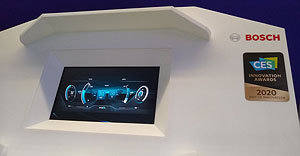 The technology has been great for years, and is improved, but it’s still “on the verge.” However, although they don’t have any deals that can be announced, they did give me an off-the-record rundown of the truly major companies they’re working on projects with that, if all goes well, should allow them to come to market sooner than remain “ongoing.” One product that can be mentioned won a CES Innovation Award. They’re developing a glassless 3D touch-display for Bosch to be used as the instrument panel in cars. (Bosch received the award, but the 3D panel was made by Stream TV Networks.) They’re also working with what they called “one of the world’s biggest makers of mobile phones, laptops and tablets” to make glassless 3D panels for each of those product lines. (And no, they weren’t exaggerating the manufacturer, who really is that big.) Stream TV is also making a 65” glassless 3D TV for major tech brand, and a gaming laptop that will use their glassless 3D panel for one of the top laptop manufacturers. Will these come to fruition? And if so, when? All I can say is that I’ve seen the glassless 3D TV, laptop, mobile phone, and car panels in operation and it’s all very real and seriously impressive. But until the deals for active projects can be finally announced, it’s still—“We’ll see…”
The technology has been great for years, and is improved, but it’s still “on the verge.” However, although they don’t have any deals that can be announced, they did give me an off-the-record rundown of the truly major companies they’re working on projects with that, if all goes well, should allow them to come to market sooner than remain “ongoing.” One product that can be mentioned won a CES Innovation Award. They’re developing a glassless 3D touch-display for Bosch to be used as the instrument panel in cars. (Bosch received the award, but the 3D panel was made by Stream TV Networks.) They’re also working with what they called “one of the world’s biggest makers of mobile phones, laptops and tablets” to make glassless 3D panels for each of those product lines. (And no, they weren’t exaggerating the manufacturer, who really is that big.) Stream TV is also making a 65” glassless 3D TV for major tech brand, and a gaming laptop that will use their glassless 3D panel for one of the top laptop manufacturers. Will these come to fruition? And if so, when? All I can say is that I’ve seen the glassless 3D TV, laptop, mobile phone, and car panels in operation and it’s all very real and seriously impressive. But until the deals for active projects can be finally announced, it’s still—“We’ll see…”
This seems a good time for an intermission. We’re at the hallway point, and your eyes have likely been straining. So, stretch your legs, take a bathroom break, or perhaps get a snack for energy. We’ll wait…
Okay, welcome back. You’ve made it through the first part, so the rest is now downhill.
Another field like TV I tend not to write about much is cameras, since it’s an ocean-like tsunami where even mobile phones have top quality lenses. But the Mevo Start caught my eye, which makes livestreaming brain-dead easy, most especially for beginners. It’s an all-in-one way to get live content online. Using the Mevo Start app, you set up what social media platforms you use, and the camera will then automatically upload your video instantly to those sites as you shoot. (You can also save the material first to an SD card to edit and upload later.) It retails for $300.
As little as I write about TVs and cameras, I write less on the automotive industry, bordering on never most years. So, it was a surprise that I found as many car-related products to write about as I did, starting with the aforementioned dashboard from Stream TV Networks and Bosch.
Indeed, car dashboards popped up throughout the show. One in particular was from Tanvas, a tactile app developer. As cars move from buttons and knobs to touchscreens, the problem is there is no “feel” to differentiate what the driver is accessing on the dashboard without looking—something that doesn’t lead to the safest driving. Haptic technology gives users a sense of touch when placing fingers on an icon, for instance a vibration or bumpy feel. This is what Tanvas is building into dashboard touchpads which auto manufacturers can install in their vehicles.
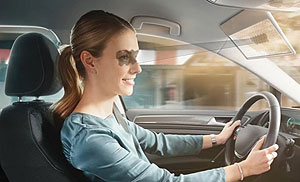 Bosch is developing a transparent LCD panel to replace the sun visor. Talking with the engineer in charge of the project, Ryan Todd, he said that the device is meant to eliminate the problem of traditional visors which not only block the sun from a driver’s eyes, but everything else the visor gets in the way of. The Bosch device uses artificial intelligence to recognize shadows on a driver’s face and then know to “block out only the area where sunlight would hit the driver’s eyes.” Being transparent, this then lets the driver see everything else in front. In fact, being transparent, the Virtual Sun Visor can be left down all the time with no need to keep flipping.
Bosch is developing a transparent LCD panel to replace the sun visor. Talking with the engineer in charge of the project, Ryan Todd, he said that the device is meant to eliminate the problem of traditional visors which not only block the sun from a driver’s eyes, but everything else the visor gets in the way of. The Bosch device uses artificial intelligence to recognize shadows on a driver’s face and then know to “block out only the area where sunlight would hit the driver’s eyes.” Being transparent, this then lets the driver see everything else in front. In fact, being transparent, the Virtual Sun Visor can be left down all the time with no need to keep flipping.
Click-It is a CES Innovation Award-winner that parents might appreciate for their new teenage drivers. It’s a sensor built into a seatbelt that sends a text message to someone (oh, like a parent) if a seatbelt isn’t being worn when the car is moving.
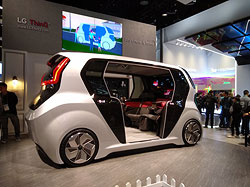 Self-driving cars have cropped up the past few years, with shuttle vans the most prominent. These have morphed into not just self-driving, but fully-connected cars, and the LG Adient is one of the more sci-fi styled I’ve seen. It almost is a mobile home entertainment center. There’s a normal front window, but this can change to opaque to give passengers options to choose from—movies, sporting events, music and even an AR view (augmented reality, where you see the real world but with added images to it, as opposed to VR, all “fictional” virtual reality).
Self-driving cars have cropped up the past few years, with shuttle vans the most prominent. These have morphed into not just self-driving, but fully-connected cars, and the LG Adient is one of the more sci-fi styled I’ve seen. It almost is a mobile home entertainment center. There’s a normal front window, but this can change to opaque to give passengers options to choose from—movies, sporting events, music and even an AR view (augmented reality, where you see the real world but with added images to it, as opposed to VR, all “fictional” virtual reality).
From cars, we head further down the road to the general world of travel, where there were quite a lot of intriguing or perhaps off-beat innovations.
 For instance, there was the Lil Flyer from Younglingz, showcased at Eureka Park. At its heart this is luggage on wheels, but with a big twist for parents of small kids, basically a combination suitcase and stroller. It’s designed in sort of an L-shape that has a seat for a little child who can be pulled along. There’s a seatbelt and folding handle bars and pedals (they don’t spin, but give the child stability). It weighs 50 pounds and fits in an airplane’s overhead bin. The company expects them on the market in April or May, to retail around $150.
For instance, there was the Lil Flyer from Younglingz, showcased at Eureka Park. At its heart this is luggage on wheels, but with a big twist for parents of small kids, basically a combination suitcase and stroller. It’s designed in sort of an L-shape that has a seat for a little child who can be pulled along. There’s a seatbelt and folding handle bars and pedals (they don’t spin, but give the child stability). It weighs 50 pounds and fits in an airplane’s overhead bin. The company expects them on the market in April or May, to retail around $150.
The Pocketalk is another of those personal translators that can automatically translate languages. They do 74. What they’ve added is a camera for written translations, like menus or signs. It retails for $300, and a 2-year cellular data contract is included, to connect to the translation database. After that expires, they offer service for $50 a year, though you can use any cellular data company. They also make a WiFi-only device which is less expensive, though less convenient.
When you’re on the road, there might be times when you want to print out a document or photo, and you’re not likely to carry a printer around, or have access to one when you need it. PeriPage is a tiny portable, inkless printer, about the size of two packs of cigarettes. It uses small rolls of thermal paper. The results certainly aren’t laser printer-quality, but fine for its quick purposes. Being thermal paper, this isn’t meant for keepsakes, since the results will only last about 10 years, but that’s likely more than long enough for most purposes, which is that you’re away from home and want something printed out right away. It retails for about $60.
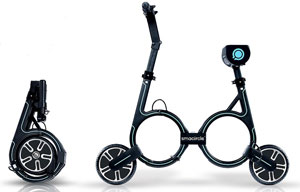 I’ve come across bicycles that fold for easy portability, to stick in your car trunk for instance. But the CES Innovation Award-winner Smacircle S1 goes even more compact—with five steps, it will fold small enough to put in a backpack. Weighing just over 15 pounds, it’s an electric cycle, as well. Though it comes very compact, it doesn’t come cheap, retailing at $1,400.
I’ve come across bicycles that fold for easy portability, to stick in your car trunk for instance. But the CES Innovation Award-winner Smacircle S1 goes even more compact—with five steps, it will fold small enough to put in a backpack. Weighing just over 15 pounds, it’s an electric cycle, as well. Though it comes very compact, it doesn’t come cheap, retailing at $1,400.
But the other of the two most remarkable product I came across at the show—which I hinted at in the beginning—was from (of all companies) Delta Airlines, who is developing it with a tech company named Misappliedscience. It's hard to describe, but I'll try. It allows airport travelers to see their travel information tailored for their own preferences in their own language displayed on message boards. No special glasses are needed. You just look at the screen, and all your personal information is there. And no one else can read it. There are different ways a traveler can be identified with this technology—what Delta uses is when you swipe your boarding pass. There are also overhead cameras in the airport that help identify the individual. (Without question, the technology receives a Cool Thing Award. As I said to the Delta tech rep, though, this is not only incredibly cool—but also a bit creepy. What she made clear is that a person can opt out of this when it’s operational. Opt out or not, the reality is that—for good or intrusive—this is a look at what tech can do in the future, and will likely require privacy laws.) The company will be testing it at Detroit Airport this summer with 100 people. There was an extensive demo of the technology, but as much as I was interested in seeing it, the line was incredibly loooooooooong, and I passed it by.
Okay, just a quick heads-up to let you know that the end is in sight. There’s still a ways to go, but at least it’s just around the bend and you can see it from here…
Ever since technology moved past the Industrial Age, robotics have been near the forefront of people’s concept of what the future of tech holds. They’ve been around for decades in manufacturing, of course, but only within the past few years has the field expanded for consumers. Still in the early stages of the home and office market, they tend to be more gimmicky than useful (generally while trying to look like a familiar, though silly, Robby the Robot), though enough are breaking through to be genuinely helpful, often looking nothing like what we think of as a traditional robot, like the impressive Wilkinson Company Breadbot that I wrote about here at last year’s CES.
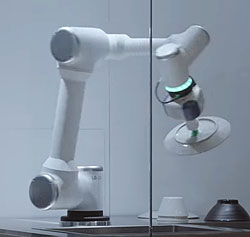 For the time being, though, traditional robots lead the pack, and the LG CLOi line has expanded to provide even more services, beyond ones like the PorterBot to help at airports, CartBot for checking out at retail stores, and LawnBot. Now, their BotTable line includes a BotChef that can cook certain foods and deliver them to you, or make and serve tea and coffee. And the BotDishwasher takes care of that afterwards.
For the time being, though, traditional robots lead the pack, and the LG CLOi line has expanded to provide even more services, beyond ones like the PorterBot to help at airports, CartBot for checking out at retail stores, and LawnBot. Now, their BotTable line includes a BotChef that can cook certain foods and deliver them to you, or make and serve tea and coffee. And the BotDishwasher takes care of that afterwards.
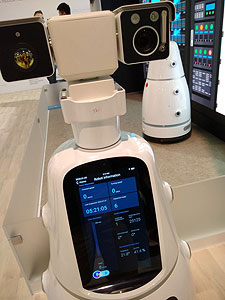 Cruzr has its AIMBOT, a monitoring robot that handles data maintenance, along with security inspections and diagnostics of a company’s computer systems by checking indicator lights and scanning readings of digital instruments.
Cruzr has its AIMBOT, a monitoring robot that handles data maintenance, along with security inspections and diagnostics of a company’s computer systems by checking indicator lights and scanning readings of digital instruments.
But I have to admit, the most fascinating robot I came across was one that was pure gimmick. However the company, OMROM, always has impressive, non-traditional (and generally practical), large-scale robotic exhibits each year, so they’ve earned the right for some fun. And beyond it being just for show, the larger point is to show the levels to which robotics can go. This was a robot that plays ping-pong. And yes, it’s silly and pointless, yet I still have to give this a Cool Thing Award. You can set it for skill level, and it will display such information as your heart rate, smile rating (I guess to perhaps recognize how much fun you’re having?), and your forehand and backhand rating. I figured that this deserved more than just a photo, so here’s a very brief video of it in action.
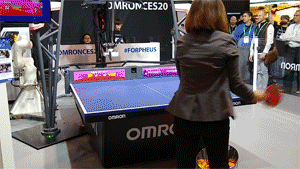 If there’s been one area of technology long-synonymous with the field even more than robotics, it’s computers, yet their presence at CES has been minimal for years. Only 15 years ago, there was an entire trade show, Comdex, held two months before CES in Las Vegas, centered entirely on computers. But that’s gone with the wind. It’s not that computers have disappeared, of course—they remain central to society—but they’ve become so standard to be almost banal. They still do have a presence at CES, though, generally as laptops, and a few caught my eye.
If there’s been one area of technology long-synonymous with the field even more than robotics, it’s computers, yet their presence at CES has been minimal for years. Only 15 years ago, there was an entire trade show, Comdex, held two months before CES in Las Vegas, centered entirely on computers. But that’s gone with the wind. It’s not that computers have disappeared, of course—they remain central to society—but they’ve become so standard to be almost banal. They still do have a presence at CES, though, generally as laptops, and a few caught my eye.
Lenovo is introducing the Lavie Pro Mobile in March. What is notable about this is how incredibly light it is, to the point that you wonder if it’s just a shell with nothing inside. (Not to worry, it worked.) It weighs a miraculous 1.85 pounds. That’s only about two ounces more than a Microsoft Surface tablet, yet is a clamshell laptop with full-keyboard (that had a nice feel). It has a 13.3” OLED screen, 8 GB of RAM and a 512 GB solid state drive. What it also has is a high price tag, $1,600. But if you regularly carry around a computer all day, that could be worth it.
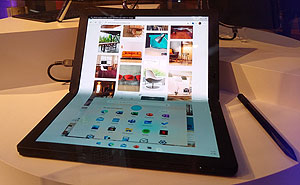 Lenovo also had one of the more uncommon laptops I’ve seen, their ThinkPad X-1 Foldable PC. Yes, foldable. The screen folds over so that when closed it’s very small, but after you open it up you get a full 13.3” OLED screen. You can use either the separate keyboard that comes with the system, or configure the bottom half of the screen to a tap-keyboard (like on a mobile phone). It can come with 5G connectivity or 4G, or just basic WiFi. The foldable laptop starts with 8G of RAM and a 256 GB solid state drive, and weighs 2.2 pounds. But the price for such compactness and foldability is high, starting at a gulping $2,500 for the base model, which will be available mid-2020.
Lenovo also had one of the more uncommon laptops I’ve seen, their ThinkPad X-1 Foldable PC. Yes, foldable. The screen folds over so that when closed it’s very small, but after you open it up you get a full 13.3” OLED screen. You can use either the separate keyboard that comes with the system, or configure the bottom half of the screen to a tap-keyboard (like on a mobile phone). It can come with 5G connectivity or 4G, or just basic WiFi. The foldable laptop starts with 8G of RAM and a 256 GB solid state drive, and weighs 2.2 pounds. But the price for such compactness and foldability is high, starting at a gulping $2,500 for the base model, which will be available mid-2020.
Speaking of foldable—which seemed to be a recurring theme this year, along with the Lenovo laptop and Smacircle bicycle—Objecto was exhibiting their folding fan which made it extremely convenient to put away when not in use, helpful for a type of product that’s usually bulky. Nice too was it had a good airflow and was very quiet.
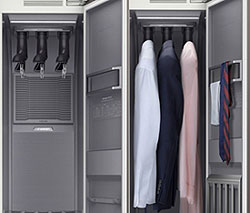 Another product for the home that was air-related, although world’s different, was Samsung’s AirDresser. The company has a wide range of Smart products for the Smart home—refrigerators, stoves, washers and more—many of which seem very beneficial, albeit overlap with offerings from other companies. The AirDresser seems unique and probably works great if you need it, but is a head-scratcher. Basically, for all the razzle-dazzle explanation, it’s a clothes steamer, one in the form of a closet for those times when you need a drycleaner fast but one isn’t available. Those times strike me as rare, and this takes around eight steps to use and costs between $1,000-$1,500. It’s very impressive, but you can get a good, significantly less-snazzy portable hand steamer for probably around $60. It won’t do as much, but I suspect most people don’t need as much.
Another product for the home that was air-related, although world’s different, was Samsung’s AirDresser. The company has a wide range of Smart products for the Smart home—refrigerators, stoves, washers and more—many of which seem very beneficial, albeit overlap with offerings from other companies. The AirDresser seems unique and probably works great if you need it, but is a head-scratcher. Basically, for all the razzle-dazzle explanation, it’s a clothes steamer, one in the form of a closet for those times when you need a drycleaner fast but one isn’t available. Those times strike me as rare, and this takes around eight steps to use and costs between $1,000-$1,500. It’s very impressive, but you can get a good, significantly less-snazzy portable hand steamer for probably around $60. It won’t do as much, but I suspect most people don’t need as much.
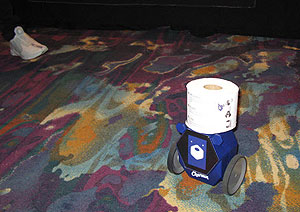 I mentioned at the very beginning of this extravaganza how it struck me from the emails I received before the show that we were in a period of technology where there were no huge breakthroughs, and so companies were in the position of having to come up with new “stuff”—often it seemed just for the sake of having something new to offer. That was the sense I got from Charmin (yes, Charmin was at CES…) with their smile-inducing, but ridiculous product, Aria. This is a “robot” that wheels around with a roll of toilet paper that you can direct to bring to you if your roll runs out when you need one. (Really.) A very nice rep for the company kept telling me emphatically and enthusiastically—despite my continued polite, but blunt denials—how valuable this is for the home, that you don't have to get up and go get a roll when needed. As I explained, I think a lot of people keep an extra roll in a bathroom cabinet, and it's actually not a problem reaching over for it. And further, if the issue is that "you don't have to get up," most people keep their bathroom door closed, so when the robot arrives, you're going to have to get up and let it in, since Charmin hasn’t included the all-important "open the door" feature. And it also requires that you remember to bring your mobile phone with the Charmin app on it with you into the bathroom. And…well, you get the idea. I added that much more important than developing this product is having a good toilet paper, which they do, and he agreed...
I mentioned at the very beginning of this extravaganza how it struck me from the emails I received before the show that we were in a period of technology where there were no huge breakthroughs, and so companies were in the position of having to come up with new “stuff”—often it seemed just for the sake of having something new to offer. That was the sense I got from Charmin (yes, Charmin was at CES…) with their smile-inducing, but ridiculous product, Aria. This is a “robot” that wheels around with a roll of toilet paper that you can direct to bring to you if your roll runs out when you need one. (Really.) A very nice rep for the company kept telling me emphatically and enthusiastically—despite my continued polite, but blunt denials—how valuable this is for the home, that you don't have to get up and go get a roll when needed. As I explained, I think a lot of people keep an extra roll in a bathroom cabinet, and it's actually not a problem reaching over for it. And further, if the issue is that "you don't have to get up," most people keep their bathroom door closed, so when the robot arrives, you're going to have to get up and let it in, since Charmin hasn’t included the all-important "open the door" feature. And it also requires that you remember to bring your mobile phone with the Charmin app on it with you into the bathroom. And…well, you get the idea. I added that much more important than developing this product is having a good toilet paper, which they do, and he agreed...
What I also noticed in this year’s pre-show inundation of emails was how many Smart locks have now appeared for the home market. There’s something great about them all—you don’t need to carry an extra key, you just punch in a code, you can give a temporary code to others when needed, you can access them by apps, and more. There is also something problematic about them all—they run on battery power, and though they give you warnings, if you miss the warnings, you can get locked out. And I haven’t found one with an ideal workaround for that yet. The best has been that some can be opened with a standard key, but then if you have a key then that limits a major benefit of a Smart lock. Tapp makes a Smart lock that has many strong things about it—it opens by fingerprint, and you can register up to 100 users for its basic model (more than necessary for most people, unless you’ve got a really big family…, though good for an office) or 500 users for their more premium model. And the app has nice features for controlling access from off-site, as well as a warning notice when power is low. But it doesn’t handle things well if you do happen to lose power. You can’t set an alarm to warn you when power reaches a certain low level, for instance. And while it can be powered back up with a portable power supply, what if you don’t have one handy? I was not impressed with their representative’s dismissive answer—“Everyone has a power supply.” Well, no, everyone doesn’t. I would suggest that most people don’t carry around a portable power supply. And I say this as someone who repeatedly acknowledges my love of portable power supplies.
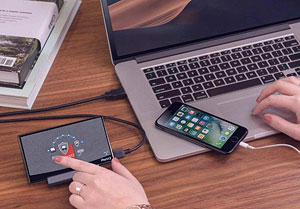 There was another security product I came across for use within the home that gets one more of my Cool Things Awards, the ResQ Protect. Mind you, I can’t tell you if ResQ Protect works as they claim. That's out of my expertise, and the product was only released last week. But if it does work as they insist, it's wonderful. The intent is to allow a user to immediately regain use of their computer after getting hit by a damaging virus or when your system has been blocked by ransomware. The way that the ResQ Protect CEO Josef Rabinovitz described his product, you connect the small box to your computer, hit the "Protect" button on the device (after your computer has been blocked or hit by a damaging virus), it downloads an image of your computer hard drive while knowing to avoid any virus/ransomware there), and you can then immediately boot your system from this now-external drive, despite your main hard drive being blocked. And you can then upload this clean version back onto your computer hard drive and start again fresh. If it works as promised, it's a great thing. It retails for $300.
There was another security product I came across for use within the home that gets one more of my Cool Things Awards, the ResQ Protect. Mind you, I can’t tell you if ResQ Protect works as they claim. That's out of my expertise, and the product was only released last week. But if it does work as they insist, it's wonderful. The intent is to allow a user to immediately regain use of their computer after getting hit by a damaging virus or when your system has been blocked by ransomware. The way that the ResQ Protect CEO Josef Rabinovitz described his product, you connect the small box to your computer, hit the "Protect" button on the device (after your computer has been blocked or hit by a damaging virus), it downloads an image of your computer hard drive while knowing to avoid any virus/ransomware there), and you can then immediately boot your system from this now-external drive, despite your main hard drive being blocked. And you can then upload this clean version back onto your computer hard drive and start again fresh. If it works as promised, it's a great thing. It retails for $300.
Good news. The end is in sight! Honest. There’s still a small bit more to go, but it shouldn’t be too painful, especially since that includes perhaps my favorite technology, so all is well.
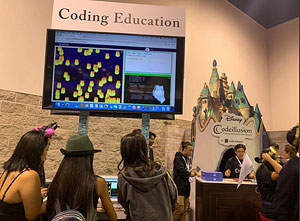 Once upon a time there was a lot of software at tech shows. Not so much anymore. But one that I spent time with is seriously good, and gets a Cool Thing Award. CodeIllusion is a remarkable, very mature product to teach children computer coding (though it would benefit adults, as well, who want to learn at a beginner’s starting point). But know that this isn’t intended to pique a child’s interest and instead is for those who really seem to love this sort of thing already, because it’s very expensive, around $1,900. But it’s tremendous. The Japanese company has partnered with Disney, and it uses the library of Disney animated films to guide the user through 125 half-hour lessons. Movies like Frozen, Snow White, The Little Mermaid, Aladdin, Pinocchio and many, many more. It’s elegantly designed and walks the student through with clips, provides the code for that sequence and then explains what it wants you to change. Seriously impressive, seriously expensive.
Once upon a time there was a lot of software at tech shows. Not so much anymore. But one that I spent time with is seriously good, and gets a Cool Thing Award. CodeIllusion is a remarkable, very mature product to teach children computer coding (though it would benefit adults, as well, who want to learn at a beginner’s starting point). But know that this isn’t intended to pique a child’s interest and instead is for those who really seem to love this sort of thing already, because it’s very expensive, around $1,900. But it’s tremendous. The Japanese company has partnered with Disney, and it uses the library of Disney animated films to guide the user through 125 half-hour lessons. Movies like Frozen, Snow White, The Little Mermaid, Aladdin, Pinocchio and many, many more. It’s elegantly designed and walks the student through with clips, provides the code for that sequence and then explains what it wants you to change. Seriously impressive, seriously expensive.
All of this technology, of course, needs power. And that means, at long last, we’ve come to the grand finale which, for inexplicable reasons, is—as I mentioned above—my favorite area of technology. Portable chargers! O huzzah. The best I can figure is that, because portable power has to be…well, portable, and therefore light and compact, developers have to be especially innovative in coming up with new and improved devices. Either that, or it’s because of some personality flaw. So, I’m going with the first option.
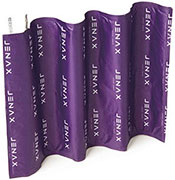 It’s also important to know that the field of portable power covers more than just specific chargers alone. For instance, there’s Jenax, which doesn’t make your standard battery. And by “not standard,” I don’t mean conductive material or capacity, I mean…it’s flexible. As a result, products that otherwise use standard batteries which make them bulky and far-more difficult to use than ideal (like wearable products that you might, say, strap on your arm) are able to take on an entirely new dimension.
It’s also important to know that the field of portable power covers more than just specific chargers alone. For instance, there’s Jenax, which doesn’t make your standard battery. And by “not standard,” I don’t mean conductive material or capacity, I mean…it’s flexible. As a result, products that otherwise use standard batteries which make them bulky and far-more difficult to use than ideal (like wearable products that you might, say, strap on your arm) are able to take on an entirely new dimension.
Portable power is also increasingly encompassing what’s known as GaNFast technology, lead by Navitas. Most batteries today use silicon. GaNFast doesn’t—“GaN” stands for Gallium Nitride,” which replaces silicon. It’s significantly faster, 100 times faster, and being so means the batteries can be smaller with great energy savings. A GaNFast battery will generally be 2-3 times smaller and offer 5 times the energy savings. Indeed the technology is so inherently fast that it will eventually eliminate the need of today’s new “Fast Chargers” for silicon batteries. The biggest challenge for GaNFast over the recent years has been that the technology is more expensive. Further, battery manufacturers are set up for using silicon and need to retool. However, within the past couple years, the price difference has plummeted to the point of almost disappearing. And that’s made the hurdle of manufacturing less of an issue. Indeed, today there are noteworthy companies like Nvidia, Ankey, Belkin and Hyper+ coming out with GaNFast batteries.
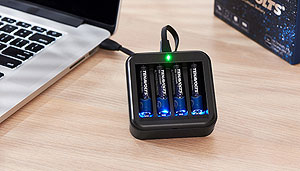 Also worth noting is the growth of Lithium Ion rechargeable batteries into the market, like those showcased by Tenavolts which is a CES Innovation Award honoree. Rechargeable batteries in the past have generally been Nickel Metal Hydride which begin to lose their charge within a few months and have a somewhat limited range of how often they can be recharged. However Lithium rechargeable batteries, like Tenavolts’, hold their charge extremely well, regulate output at a consistent 1.5 voltage and can be recharged in less than two hours, rather than up to four hours for NiMH batteries that use what’s known as a “slow charge.” (Fast charges do shorten the time for NiMH, but this runs hotter and so also shortens the lifespan of the battery.) They’re also rated for 1,000 recharge cycles. This means that unlike the normal degradation of NiMH rechargeables, they can perform at almost the same capacity regardless of how long they’ve been stored or re-used within their long lifespan. All this also makes them far-more ecologically friendly. The only downside is that they require using Tenavolts’ proprietary recharger. However, unlike most chargers, Tenavolts’ can be used plugged into a laptop’s USB port, giving users more portability. A charger comes bundled with a pack of four AA batteries for $35. After which you can get a pack of four batteries alone without a charger. (At the moment, only AA batteries packs seem to be available. And their price was just raised from what I was told at CES to now a surprising $31, only $4 less for a battery pack with no charger. A company rep said this is based on demand, though it seems an odd marketing strategy. I suspect in time this will change, but who knows? Currently, an 8-pack of rechargeable NiMH batteries go for $15-20.) Still, ultimately, this is all about developing technology, not pricing…
Also worth noting is the growth of Lithium Ion rechargeable batteries into the market, like those showcased by Tenavolts which is a CES Innovation Award honoree. Rechargeable batteries in the past have generally been Nickel Metal Hydride which begin to lose their charge within a few months and have a somewhat limited range of how often they can be recharged. However Lithium rechargeable batteries, like Tenavolts’, hold their charge extremely well, regulate output at a consistent 1.5 voltage and can be recharged in less than two hours, rather than up to four hours for NiMH batteries that use what’s known as a “slow charge.” (Fast charges do shorten the time for NiMH, but this runs hotter and so also shortens the lifespan of the battery.) They’re also rated for 1,000 recharge cycles. This means that unlike the normal degradation of NiMH rechargeables, they can perform at almost the same capacity regardless of how long they’ve been stored or re-used within their long lifespan. All this also makes them far-more ecologically friendly. The only downside is that they require using Tenavolts’ proprietary recharger. However, unlike most chargers, Tenavolts’ can be used plugged into a laptop’s USB port, giving users more portability. A charger comes bundled with a pack of four AA batteries for $35. After which you can get a pack of four batteries alone without a charger. (At the moment, only AA batteries packs seem to be available. And their price was just raised from what I was told at CES to now a surprising $31, only $4 less for a battery pack with no charger. A company rep said this is based on demand, though it seems an odd marketing strategy. I suspect in time this will change, but who knows? Currently, an 8-pack of rechargeable NiMH batteries go for $15-20.) Still, ultimately, this is all about developing technology, not pricing…
And I would be remiss if I didn’t mention at least one portable charger. One of my favorite companies, myCharge, is introducing an updated version of their HubTurbo which will now include both a USB-C and Lightning plug built-in, along with a built-in wall plug. With an 18W output, it’s also a Fast Charger. A 6,700 mAh charger will retail for around $80.
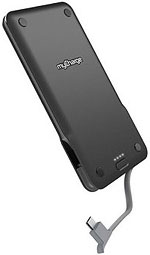 But—far more important to me (and I admit this is totally personal), myCharge is bringing back an updated version of what was my favorite charger, but had been discontinued about 3-4 years ago, the Talk & Charge. And even better, it now includes a USB-C plug built-in, so it can be used with most new mobile phones. It’s now called the PowerPlus, a very thin, properly narrow and very light portable charger that’s exceedingly easy to carry in a shirt pocket and wonderfully designed in a way (as befits its former name) to let you hold your mobile phone SO conveniently even while charging. A 10,000 mAh model will retail for around $60. So—this Spring…it’s back! O huzzah.
But—far more important to me (and I admit this is totally personal), myCharge is bringing back an updated version of what was my favorite charger, but had been discontinued about 3-4 years ago, the Talk & Charge. And even better, it now includes a USB-C plug built-in, so it can be used with most new mobile phones. It’s now called the PowerPlus, a very thin, properly narrow and very light portable charger that’s exceedingly easy to carry in a shirt pocket and wonderfully designed in a way (as befits its former name) to let you hold your mobile phone SO conveniently even while charging. A 10,000 mAh model will retail for around $60. So—this Spring…it’s back! O huzzah.
(CAVEAT: This here is not the PowerPlus, since the charger isn’t available yet, but I tracked down a graphic of the earlier Talk & Charge which looks near-identical.)
And so, with that, we power down, unplug and trundle off to a Safe Place until next year, when CES once again boots up…
To read more from Robert J. Elisberg about other matters from politics, entertainment, technology, humor, sports, and a few things in between, see Elisberg Industries. He can also be followed at a distance on Twitter or Facebook.
Note: The Writers Guild of America West neither implicitly nor explicitly endorses opinions or attitudes expressed in this article.
Copyright 2020, Robert J. Elisberg. All rights reserved.
